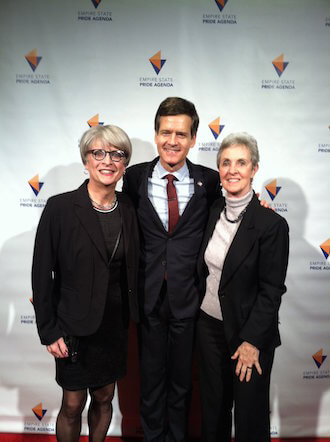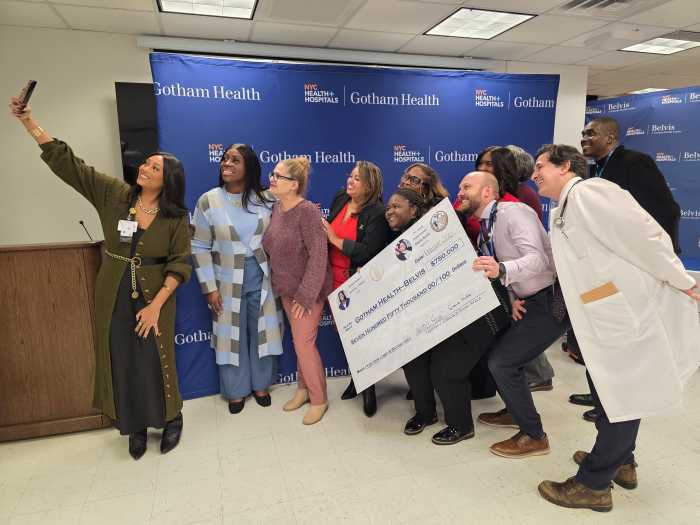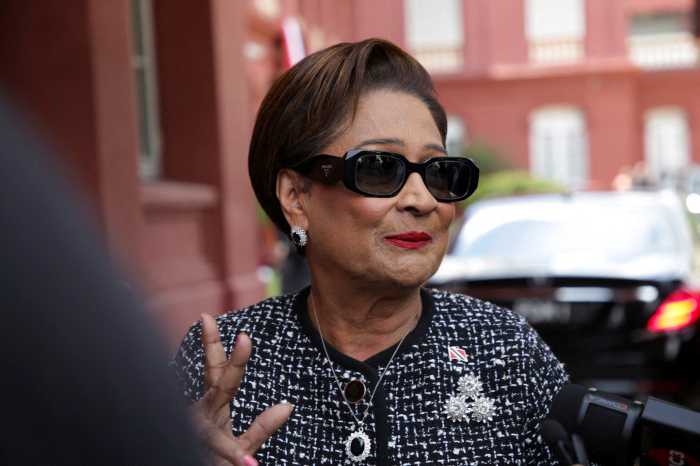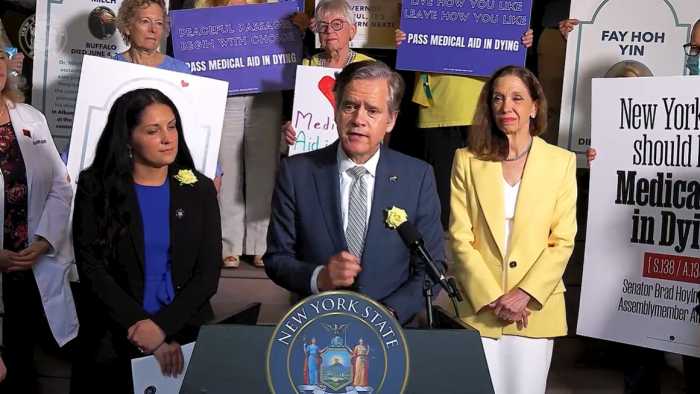Governor Andrew Cuomo and Dr. Howard Zucker, the interim state health commissioner, at last June's Pride Parade announcing New York’s commitment to a plan to effectively end the AIDS epidemic by 2020. | GAY CITY NEWS
Governor Andrew Cuomo made no mention of the Plan to End AIDS in his State of the State address and his description of his proposed state budget suggested his administration is not committing any new dollars to implement that plan.
“I’m disappointed that the governor didn’t mention it,” said Charles King, chief executive officer at Housing Works, an AIDS group, and the co-chair of the 63-member task force that drafted recommendations to the governor regarding the plan. “I hope it was just in the interest of brevity.”
Cuomo spent the first 30 minutes of the hour-and-20-minute speech talking about the tax cuts he and the Legislature enacted over the past four years and the economic development successes of his first term. He proposed reducing the tax rate for small businesses from 6.5 percent to 2.5 percent and delivering $1.7 billion in property tax relief for homeowners.
January 21 speech offers no direct response to advocates’ recommendations, but suggests no new money
“The next taxes we have to attack are the property taxes,” Cuomo said. “When people complain about high taxes in New York, they’re talking about the property tax.”
Cuomo then turned to promoting tourism and infrastructure development. Among his proposals was building four new Metro-North stations in the Bronx and naming one after Ruben Diaz. The governor’s press office did not respond to a call asking if that referred to State Senator Ruben Diaz, a leading anti-LGBT figure, or Ruben Diaz, Jr., the Bronx borough president and the senator’s liberal, pro-LGBT son.
Cuomo briefly discussed some proposals to address poverty and then engaged in a far longer discussion of education reform. His proposals to evaluate teachers and open more charter schools will doubtless be opposed by the state teachers’ unions. Cuomo told legislators that if they enacted his education reform measures, he would increase the state education budget by $1.1 billion. The increase he is currently proposing is $377 million.
Following a discussion of his “social justice agenda” (in which the governor reiterated his support for the Gender Expression Non-Discrimination Act, a long-stalled transgender civil rights measure, but only in the address' written form, not as delivered), he told the crowd that aside from increases in the education budget and Medicaid spending, “the rest of the state budget is basically flat.” That suggests that the big ticket items in the Plan to End AIDS, such as housing for the estimated 10,000 to 12,000 people with HIV in the state who need it and creating a single point of access to government benefits for those people, are not funded in the state budget for the next fiscal year, which begins on April 1.
King had earlier estimated that the housing would cost $100 to $120 million annually. When the single point of access was proposed in New York City in 2007, the cost just to the city was $68 million annually, according to estimates from advocates, while the City Council projected it would cost $75 to $100 million a year. Currently, only people with an AIDS diagnosis are eligible for Medicaid, housing subsidies, food stamps, and other government benefits.
“That’s a huge, huge one,” said Gina Quattrochi, the chief executive officer of Bailey House, an AIDS housing group, referring to the single point of access. “That’s going to cost a lot of money.”
Budget documents suggest that people with HIV will be included in a $116 million item to build 5,000 housing units over five years, though those units are also for people with special needs and others who are homeless. Another $27 million will be used for rental assistance for people with AIDS. Those dollars are from a one-time $440 million settlement from a lawsuit.
The budget partially decriminalizes possessing syringes and it bars police and prosecutors from using condoms as evidence when the person possessing the condoms is charged with a misdemeanor or violation. The task force’s plan sought full decriminalization of needle possession and favored an outright ban on using condoms as evidence in any crime. Condoms are typically used as evidence when a person is charged with prostitution, which is a misdemeanor.
Gay City News was told that the budget contains funds to pay for pre-exposure prophylaxis (PrEP), anti-HIV drugs for HIV-negative people to prevent them from becoming infected. As the newspaper went to press, that allocation could not be found in details provided by the governor’s office online.
In June, Cuomo endorsed the plan that will use PrEP, post-exposure prophylaxis (PEP), and treatment as prevention (TasP) to prevent new HIV infections. HIV-positive people who adhere to their treatment regimen are generally regarded as non-infectious. The goal is to reduce new HIV infections in New York from the current roughly 3,000 annually to 750 by 2020.
Earlier comments by Dan O’Connell, the director of the state AIDS Institute, suggested the Cuomo administration was not going to spend a great deal of new cash on the plan.
“New York already spends more money than any other state on HIV services,” O’Connell said on a January 13 appearance on Capital New York, an Albany cable news program. “It’s not so much a huge new investment. It’s being as smart as we possibly can and being as aggressive as we possibly can to eliminate new infections and to keep people from progressing from HIV to AIDS.”
State law allows the governor to amend the proposed budget for 30 days and then the Legislature votes up or down on it. Even before Cuomo’s speech, advocates were saying they were prepared to fight for their proposals.
Their position did not change.
“There would have to be a new state allocation,” Quattrochi said. “The whole plan cannot be implemented with no new money.”






































